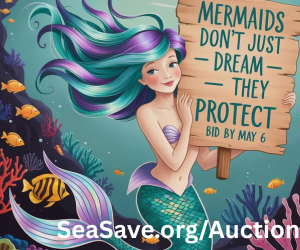The sites we dive are often dictated by conditions. Weather permitting, I prefer to dive the most exposed points possible, but when the northeasters kick up I look for more protected sites. In the middle of Carmel Bay is a site that is protected from the swell on most days, yet has plenty of exposure to ocean currents and excellent marine life.
Between the Copper Roof House and the Butterfly House is an extensive, healthy bed of giant kelp. The far edge of the kelp bed is too far to reach by swimming from shore, so this is a “boat only” site. At Outer butterfly most divers anchor their boat at the edge of the kelp bed and can head offshore or inshore for two different dives.
Divers may head east into the kelp. This is one of the thickest beds in the Monterey and harbors a great deal of life. It is possible to find shallower water by heading inshore but better diving is in the deeper water. Look for otters napping in a wrap of kelp. Also, look for an assortment of snails, fish, nudibranchs, and bryozoans living on and among the kelp fronds.
The bottom beneath the kelp is rocky, and the depths here vary between 50 and 60 feet. Rocks are covered with anemones, tunicates and bryozoans. There are plenty of critters and color for the most discriminating of photographers. Schools of señoritas forage through the columns of kelp along with schools of small blue rockfish.
Offshore of the kelp bed you will find deeper water and more interesting bottom topography. Running perpendicular to shore are a series of rocky ridges. The tops are in 50 feet of water and the bottoms are at 70 to 90 feet, with a mixture of sand and rock in between the ridges. In most places the ridges are nearly vertical or have pronounced overhangs, creating a series of mini-walls and small caves. The walls are covered with lots of colorful invertebrates—mostly sponges, cup corals and anemones. Look for crabs hiding in the large crevices, and chestnut cowries in the smaller ones.
What is really impressive with this area is the fish life. There are numerous lingcod sitting on rocky perches. Most of these are covered with scores of copepods. There are also a large numbers of vermilion rockfish (a.k.a. redfish), grass and kelp rockfish, and cabezon. This is a fish photographer’s heaven since the fish here are particularly friendly and often line up to have their portraits taken.
California sea lions often pass through this area. These large mammals are very curious and often spent time checking out divers. If you focus your attention on something along the bottom, the sea lions cannot help themselves and approach at close range to investigate what you are looking at.
Outer Butterfly is a safe and comfortable dive when more exposed spots like the Pinnacles and Cypress Point are blown out. Yet, it has plenty of things to look at and to photograph. It fact, it is one of the best spots around for fish photography. Windy or calm, it’s a great dive.
Dive Spot At A Glance
Location: About 1/2 mile offshore of Carmel, between the Copper Roof House and the Butterfly House. Divers should note that the Copper Roof House has been reroofed and is no longer copper-green.
Access and Entry: Boat access only. Boats may be launched from Stillwater Cove or the Monterey Breakwater. Alternatively kayaks may be launched from either the Copper Roof House or Carmel River State Beach. It’s too far to swim from shore.
Skill Level: Intermediate to advanced.
Depths: 50 to 90 feet.
Visibility: Good, usually around 30 feet, but can be 50 feet or more.
Photography: Good macro and great wide-angle photography. Good spot for fish photography.
Hunting: This area is part of the Carmel Bay Ecological Reserve and no invertebrates may be taken.
Hazards: Watch for currents, boat traffic, and thick kelp.







